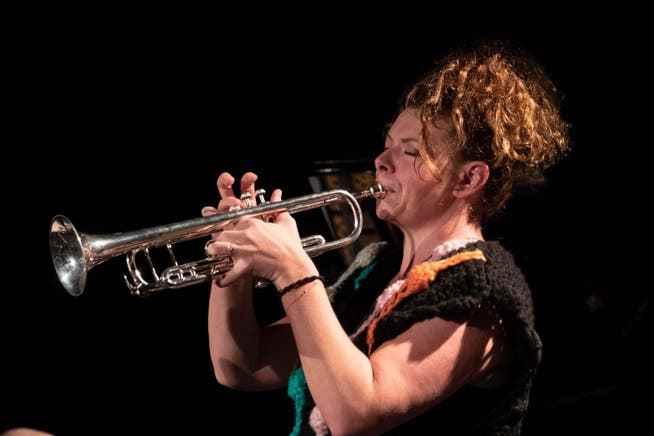Mournful elegies and austere fanfares. Abstract concepts and spontaneous fervor. Israeli and American musicians make the festival “unheard of!” on Saturday evening to the Humanity Forum.
The Israeli Avishai Cohen sings and speaks on the trumpet.
A great thing, this glistening, metallic thing. You hold the trumpet to your mouth, blow into it, and then clear, full sounds resound straight from your soul. Instruments are actually foreign bodies that are supposed to amplify our possibilities of expression in all directions. And yet music, and jazz in particular, is about being able to appropriate it or even absorb it.
Avishai Cohen succeeds so well that his trumpet becomes a mouthpiece, a second voice. Right at the beginning of his concert on Saturday evening as part of the Zurich festival «unheard!» the Israeli sets the tone – with soft fanfares that add up to sentimental messages. It is as if he were speaking or singing with his instrument, sometimes leaving room for the bodily cues of sighing and snorting. For the most part, however, his sometimes virtuosic, sometimes elegiac playing seems embedded in the calm pneuma of self-confidence.
Organic interplay
The impression of sovereignty and security is transferred to the whole band. In Avishai Cohen’s quartet, on the one hand, the tasks seem to be clearly distributed – everyone knows what they have to do, the accompanists don’t bother the soloist. And yet, on the other hand, there is a lively debate, an empathetic exchange. On the program is Cohen’s eight-part suite “Naked Truth”. In jazz, the genre of the suite often serves as a vehicle for exploiting ideas that are not enough on their own within the framework of a larger composition. This is not the case here, one rather has the feeling that the composition unfolds from the organic interplay of the four musicians as if by itself.
Melancholic melodies, dance motifs and bebop quotations prove to be the binding themes that are negotiated and further developed in the quartet’s interplay. The trumpeter introduces them, and as they gradually seep through the accompaniment, he expands and varies them to pave the way for open improvisation. The three accompanists each stand for their own dimension, which together determine the space for the solo freestyle.
Bassist Barak Mori defines the vertical: his compassionate playing rounds out the trumpeter’s messages, giving them depth but weight and warmth at the same time. The pianist Yonathan Avishai, on the other hand, works on the horizontal. He sits in front of the keyboard in stoic calm. The gaze is lost over the stage while the hands spread out over the keys in arpeggios, creating a harmonious panorama that shimmers in finely graded nuances. But the shifting of the chords also generates the tension that is discharged in the electrifying drive of the drummer Ziv Ravitz. As often as Ravitz interferes sensitively and quick-wittedly in Cohen’s improvisational flow, the high points of this already high-quality concert are guaranteed.
The brotherly bravado of the Avishai Cohen Quartet becomes even more apparent in the second part of the evening. Once again a quartet is on the program, again the trumpet plays the first violin. This time she is played by Steph Richards. The Canadian, who moves in different camps of contemporary music in Brooklyn, New York, tries to open up the vastness of atonality through formal concepts. This sometimes leads to compelling results. But not always – even seldom.
On the one hand, this is due to the composition of their band: the pianist Joshua White is a bundle of energy, his eruptive virtuosity is impressive in itself. But his playing is so focused on percussive effects that he almost cuts off the rhythmic breath of his colleagues on electric bass and drums (Stomu Takeishi and Max Jaffe).
Punctuation instead of spontaneity
The eyes of the four musicians are often glued to the sheet music, their actions seem a bit uncertain and indecisive. The compositional specifications often turn out to be too abstract and fragile, which is probably why the bandleader repeatedly feels forced to conduct makeshift music. The performance gives the impression that the trumpeter has defined the interplay in advance through the punctuation – and the improvising interlocutors have to stick to commas and periods, question marks and exclamation marks everywhere in their spontaneous discussion.
It’s no wonder that the music often seems rather bloodless, despite its intensity and volume. And then suddenly there are magical moments. Where the pieces are characterized less by artistic pretensions and more by concrete ideas – by melodies, for example, or rhythmic patterns – Steph Richards can also shine with gripping tones and suggestive poetry.

